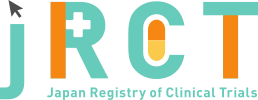臨床研究等提出・公開システム
|
Mar. 25, 2019 |
|
|
May. 25, 2022 |
|
|
jRCTs052180158 |
A study on the effectiveness of balance rehabilitation support robot (balance exercise assist robot) for Parkinson's patient. |
|
The effect of rehabilitation robots for patients with Parkinson's disease. |
|
Aug. 31, 2021 |
|
12 |
|
The subjects were those with a total BESTest score of less than 75%, an MMSE score of at least 24 points, Hohen-Yahr severity class I to III, and stable Parkinson's disease medication. In the BEAR group, the male to female ratio was 3 males and 6 females, the mean age was 71.7(SD: 3.9), years, the mean BMI was 20.9 (SD: 1.7), the mean UPDRSIII was 37.9 (SD:12.4). In the PT group, the male to female ratio was 3 males, the mean age was 66.3 (SD: 5.7) years, the mean BMI was 24.8 (SD: 2.3), and the mean UPDRSIII was 34.5 (SD: 11.1). |
|
This study started on March 16, 2018, the date of approval by the Ethical Review Committee of Hyogo Medical College; from March 25, 2019, the study was continued as a specific clinical research with the approval of the Clinical Research Review Committee of Hyogo Medical College, and recruitment of subjects was conducted until March 31, 2021. Data collection was conducted until October 31, 2021. The total number of recruited subjects was 30, and 11 subjects declined to participate in the study after listening to the research explanation. There were 6 patients who did not meet the eligibility criteria.We randomly divided the 13 patients who met the eligibility criteria into 2 groups: 9 patients in the BEAR group, 6 of whom completed Follow up 12W due to the spread of COVID19; 4 patients in the PT group, 1 of whom dropped out due to a fracture caused by a fall at own house; and 3 of whom completed Follow up 12W. The patient in which was discontinued were not included in the analysis becouse the patietns was undergone only pre evaluation. |
|
One patient suffered a fracture due to a fall during the research institute, although no illnesses or other events were considered to have occurred in relation to the study. The patient was allocated to the PT group, and after three sessions of exercise therapy, she suffered a fracture. As the patient had a history of falls before participating the study, the fall did not occur during exercise therapy, and the fall did not occur on the day of the exercise therapy, the disease was considered to be unrelated to the study. With the exception of this one case, no illnesses or other problems occurred during the study. |
|
A two-way analysis of variance showed no statistically significant interactions for the primary or secondary endpoints. The BESTest of the BEAR group showed a statistically significant difference in total points between pre and Follow Up (FU) 4W as a result of the Turkey-Kramer multiple comparison test. There was a statistically significant difference between pre and Follow Up (FU) 4W in total points as a result of multiple comparison test by Turkey-Kramer. The BESTest in the PT group showed a statistically significant difference in total points between pre and post as a result of the multiple comparison test by Turkey-Kramer, and a statistically significant difference between pre and post in SessionI, a sub-item of BESTest. |
|
Both groups showed improvement in BESTest; the BEAR group showed improvement at FU4W, and analysis of the BESTest sub-items revealed that improvement in reactive postural control was related to the BESTest total score, suggesting that postural adjustment ability was improved by postural reflexes and feedback from the system senses in BEAR group. In the PT group, there was an improvement in the BESTest total score after implementation, indicating that muscle strength and posture were involved. |
|
April. 30, 2022 |
|
No |
|
No applicable. |
|
https://jrct.mhlw.go.jp/latest-detail/jRCTs052180158 |
Domen Kazuhisa |
||
The hospital of Hyogo College of Medicine |
||
1-1 Mukogawa-cho Nishinomiya city Hyogo, Japan |
||
+81-798-45-6881 |
||
domen@hyo-med.ac.jp |
||
Sota Koichiro |
||
The hospital of Hyogo College of Medicine |
||
1-1 Mukogawa-cho Nishinomiya city Hyogo, Japan |
||
+81-798-45-6358 |
||
ksota@hyo-med.ac.jp |
Complete |
July. 19, 2018 |
||
| July. 19, 2018 | ||
| 50 | ||
Interventional |
||
randomized controlled trial |
||
open(masking not used) |
||
active control |
||
parallel assignment |
||
treatment purpose |
||
Clinical diagnosis of Parkinson's disease |
||
Mergers of neurological diseases other than Parkinson's disease |
||
| 40age old over | ||
| 80age old under | ||
Both |
||
Parkinson's Disease |
||
Robot group: The participants performs twelve per a session, 2sessions per a week for 8 weeks. |
||
D010300 |
||
Balance Evaluation Systems Test (BESTest) |
||
10m walking time and steps |
||
| TOYOTA Motor Corporation | |
| Not applicable |
| The Certified Review Board of Hyogo College of Medicine | |
| 1-1 Mukogawa-cho Nishinomiya-city Hyogo, Japan, Hyogo | |
+81-798-45-6066 |
|
| rinken@hyo-med.ac.jp | |
| Approval | |
Mar. 04, 2019 |
| UMIN000033454 | |
| University Hospital Medical Information Network |
none |
